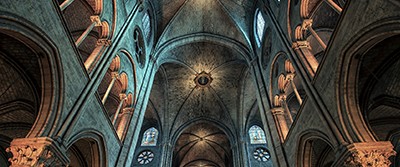Notre Dame: Rebuilding History with Science

By Mike Howie
The world looked on in sadness as Notre Dame Cathedral burned in April 2019. The Parisian landmark, which has stood in the city’s center since medieval times, lost its iconic spire and much of its wooden roof. However, most of the structure and the artwork inside were saved from the blaze thanks to the tireless efforts of Paris fire brigades.
High-Tech Tools
As fire fighters worked through the night, they had technology on their side. They flew two DJI drones, a Mavic Pro and a Matrice 210, to monitor the fire and help them plan how to use available resources. While drones aren’t typically allowed to fly in Paris, DJI cooperated with French authorities by temporarily removing the geofencing that prevents their drones from flying in restricted areas.
Fire fighters also enlisted the help of an 1,100-pound robot named Colossus to fight the fire within the cathedral when conditions became too dangerous for humans. The waterproof, fireproof machine used a motorized cannon that can spray more than 660 gallons of water per minute to lower temperatures inside the nave. Ultimately, the robot helped to save human lives as well as the structure, including the famous belfries.
Learning from Disaster
Now that the fire is out, the French government and other organizations are beginning to plan efforts to restore Notre Dame, and many see this as a learning opportunity. The Laboratory for the Restoration of Historical Monuments in Champs-sur-Marne, France, for example, is looking to science to help with the restoration, learn more about the cathedral, and better understand the behavior of certain materials. And the French National Centre for Scientific Research plans to analyze isotopes in the timber frame — samples of which wouldn’t otherwise be available — to gain insights into medieval climate.
Laser-Accurate Restoration
While the restoration process will take years and possibly even decades to complete, workers will have detailed 3D models to use as a guide. In 2000, renowned architectural historian and Vassar Associate Professor of Art Andrew Tallon used laser technology and advanced imaging techniques to build a digital model of Notre Dame. Over five days, Tallon scanned the building 50 times and gathered more than one billion data points, which could now be invaluable in rebuilding the cathedral.
Tallon’s scans are even accurate enough to help recreate the cathedral’s fallen gargoyles and chimeras. Dutch company Concr3de — a specialist in stone 3D printing for construction — claims that it can use rubble and ashes from the broken statues to 3D print exact replicas. After grinding the limestone rubble and combining it with fire ashes and other materials, they could use Tallon’s models as a guide for their printers.
Discussion Questions
- What made the Notre Dame fire so difficult to fight?
- How could similar fires be prevented?
Vocabulary
- 3D printing
- Isotope
- Geofencing
- Medieval

